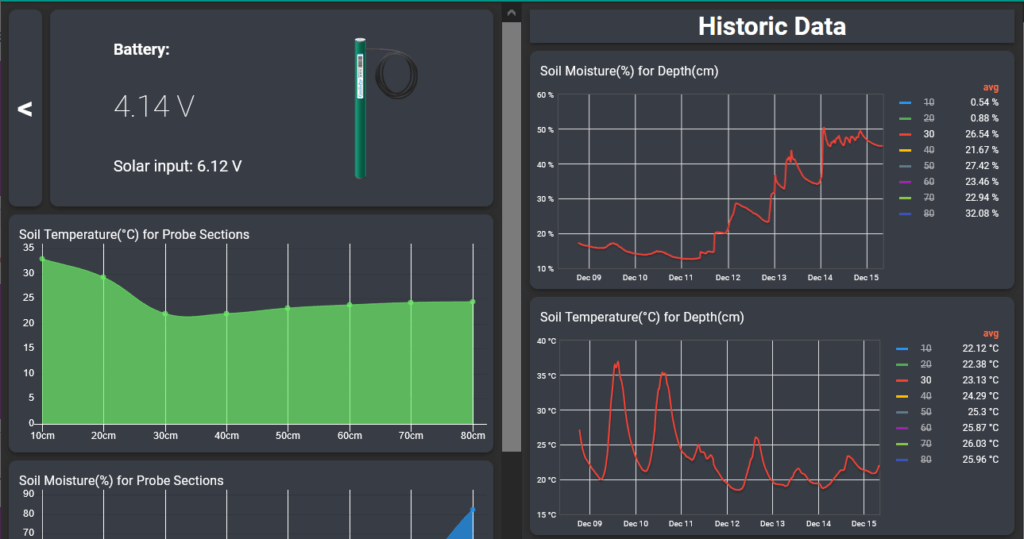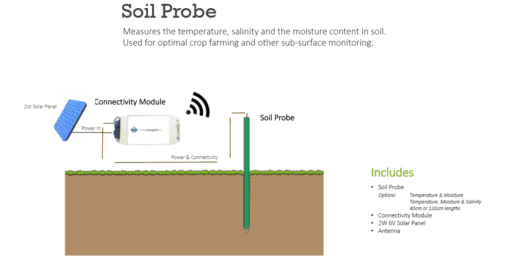
Same Day
Shipping for
Online Orders
Before 2pm
30 day
Money Back
Guarantee
Australia is the driest inhabited continent in the world; 70% of it is either arid or semi-arid land. The arid zone is defined as areas which receive an average rainfall of 250mm or less. The semi-arid zone is defined as areas which receive an average rainfall between 250-350mm. 1
Australia’s variable climate means it is critical to preserve and utilise every bit of available moisture. Water is the constraining factor in rainfed crop farming systems. While seasonal rainfall is a major factor in the ultimate yield of a crop, the water-holding capacity of the soils also plays a role. Over the past couple of decades, soil moisture has increasingly come into focus for farmers with land management techniques being employed to reduce the amount of erosion, improve infiltration and reduce evaporation.
Understanding soil moisture
Farmers can keep track of their soil moisture using soil moisture sensors, or moisture probes. Having an improved understanding of soil water gives them a better understanding of the yield potential of their crops, and therefore allows better decision-making around whether to apply inputs such as nitrogen and if so, how much, allowing for better water management.
Soil moisture sensors are fairly standard now in irrigated cropping systems, but increasingly, dryland farmers are looking to better understand their soil moisture as well. There is a range of soil moisture probe providers and the units are coming down in price as the technology improves. The units themselves are becoming more reliable and robust.
So how do you decide whether a soil moisture sensor can add value to your farm business? And if you do want to install them, how do you decide which devices to choose and how much to pay? Once that is decided, how and where should they be installed, the next hurdle is how do you interpret the data they generate?
First and foremost, any AgTech solution should provide insight or solve a problem on your farm, so consider what problems a sensor may solve for you. When installing soil moisture sensors, start with just a few devices before deciding whether to roll out probes right across your property or properties.
Connectivity
One thing that is important to consider is connectivity – soil moisture sensors rely on connectivity to send their data. There are numerous options available in varying stages of commercialisation, and the market is evolving quickly with the adoption of new technology, so it is advisable to do some research on the best option for your operations. Not all options may be available to you, and coverage may be limited or expensive in your area.
Connectivity options include:
- Mobile (CATM1)
- WiFi
- LoRaWAN
- Low Orbit Satellite
- NarrowBand Internet of Things (NB-IoT)
- Bluetooth
- Sigfox
The myinsight.io system is revolutionising the way Australian farmers do business.
myinsight.io is an Internet of Things/Everything (IoT/E) connectivity platform designed to connect any device to a centralised dashboard, enabling you to gather insights through data, make better-informed decisions and eventually automate the farming process. The system can connect as few as one device, to several thousand devices, allowing you to build a clear picture of your entire operation –soil moisture penetration, weather station data, flow rates, tank levels, camera monitoring, fuel and chemical reserves, activate pumps and lighting – the possibilities are limitless.
The Connectivity Module is a smart bit of electronics that connects to a sensor and transmits the data to the online dashboard either wirelessly or by cable. There’s no complex setup, the one module can be supplied compatible with all major wireless standards (NB-IoT, LTE-M, LoRa, Sigfox, Bluetooth, WiFi). As an Australian made device, the Connectivity Module is designed to be installed outside and can handle even the toughest of weather conditions.
Site selection
Choosing appropriate sites for your soil moisture sensors can be tricky because the sensor relays data to an adjacent connectivity unit or ‘base station’, either via cable or wirelessly. Because proximity to the base station is important, the probe often needs to go near the edge of a paddock, which may not necessarily be the most representative location for that paddock’s soil moisture content. If cables are in use, some compromises may be required as care needs to be taken during operations such as top dressing or spraying. Alternatively, you may need to invest in solar power for an off the grid solution.
Using the moisture data
The first year of installation will usually be focused on recording the Plant Available Water Capacity (PAWC), the maximum amount of water stored in a soil profile that can be used by plants. Different soils have different PAWC values. PAWC is the difference between the soil’s water content at the drained upper limit and the crop lower limit. Getting a full picture of what is going on in your soils may take three or four years.
Essentially, sensors display the soil moisture levels relative to an upper limit (soil saturation) and a lower limit (the onset of plant stress). Graphs are usually ‘stacked’ and show how the soil moisture has tracked over time. This allows the farmer to see how much moisture a crop draws down as it fills grain in the spring, i.e. how fast a crop is using the available moisture in the soil.

As the plants’ roots move deeper, they extract moisture during the day and shut down at night and the next sensor down will exhibit ‘stepping’ as the roots move deeper. This can be useful to show where the roots are active and help with decisions such as whether to top-dress fertiliser. For example, if the top layers of soil have dried out and the roots are active much further down (beyond 60cm), an application of nitrogen may not provide value, because it would rely on significant rainfall to move the nutrients through to the layer where the roots are active.
In the longer-term, gaining an understanding of how long a full profile of soil moisture lasts in normal spring conditions provides farmers with essential information during the growing season. By adding further options such as rain gauges and weather stations, farmers can build a comprehensive picture that allows them to make decisions around crop management with more confidence.
myInsight.io is a product of Powertec and is a full-service complete end-to-end IoT/E ecosystem. It is comprised of an open-source solution, covering internet, cellular, WiFi and long-range communication (LoRa) gateways. The solution is customised to control, measure and track: assets, people, animals and things, with a combination of live and historical data including events, notifications and machine learning.
For more information on our range of soil moisture sensors or a complete end to end connectivity solution contact the team today sales@powetec.com.au or 1300 769 378

Powertec provides full network design
services.
Contact our team to begin your automation journey today on 099516205 or solutions@powertec.com.au







